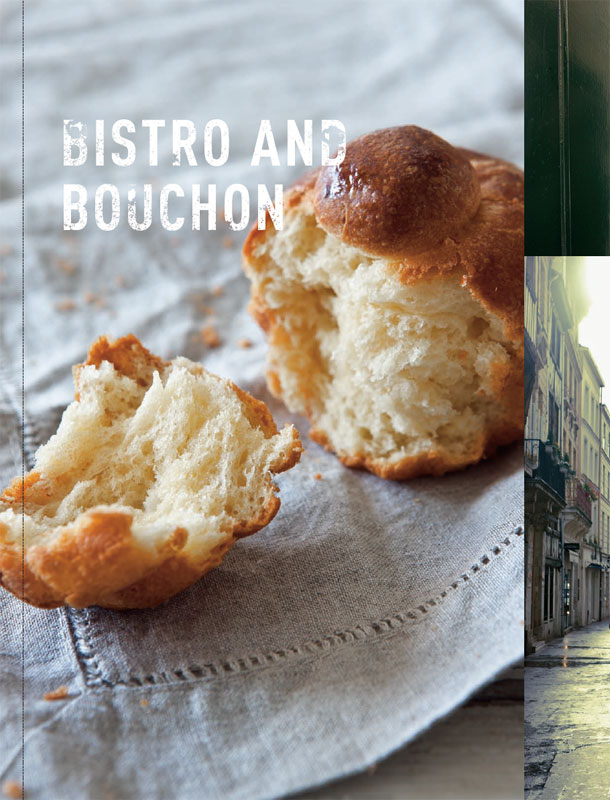
BISTRO AND BOUCHON
On a rainy Friday night in the narrow cobblestoned streets of Lyon, there are gales of laughter erupting from a number of little restaurants. They’re all lit with the same golden light and full of the most delicious cooking smells. Not surprisingly, everyone wants a seat inside, and many have customers lining up waiting for tables.
This type of restaurant is found only in Lyon in the city centre – it’s called a bouchon and is an unpretentious worker’s cafe that has been going strong since the sixteenth century. There are about twenty or so left, all of them once canteens for local silk workers.
The food served at bouchons is inexpensive, with serving sizes the opposite of haute cuisine, as this is hearty fare to sustain you. Each bouchon is presided over by a patron – usually male and voluble; someone who remembers regulars and their tastes, including the wine they like (which isn’t too hard with only a few types served in carafes). There is no written menu as the patron either tells you what’s on offer or it is scrawled on the mirrors that line the wooden interiors.
Yves Rivoiron is the patron of the Café des Fédérations, a man with a cheeky grin and a loud voice, who wears ties that are even louder with illustrations of pigs in compromising situations. ‘The patron calls the shots in a bouchon,’ he explains. ‘In a restaurant the client’s always right. Not in a bouchon! In a bouchon we indulge the clients – they don’t even need to order. The food comes, the wine comes. It’s just like home really … Except that you have to pay!’
Lyon’s bouchons serve food that is distinctly Lyonnaise – from a simple frisee salad scattered with walnuts and tossed in blue-cheese dressing, to the classic lentil salad, ‘the caviar of the poor’, of puy lentils dressed with vinaigrette. Main courses are made with what have traditionally been low-cost ingredients – offal, certain types of fish, vegetables. Favourites are tablier de sapeur (crumbed and pan-fried tripe), calves feet and heads, chicken liver, lamb’s brain, pike, cardoons and swiss chard.
More widely spread across France are bistros. There is no more popular place to eat and drink than these down-to-earth establishments bustling with activity and brisk service. The tables are close together and the menu is limited, changing with the seasons.
Bistros are said to have come into being during the Russian occupation of Paris in 1815, when soldiers were in need of a quick meal and drink. The Russian word ‘bystra’ means ‘hurry’. These origins are disputed, but in any case bistros are one of the delights of travelling through France, their food both wonderful and unfussy. We spent time with top chef Yves Camdeborde, who trained in some of the highest Michelin-starred restaurants in France before he decided a move to a more relaxed style of dining that was simply more fun. His bistro Le Comptoir in Saint-Germain, Paris, was at the time of writing still the hottest ticket in town, booked out months in advance.
Yves explains that a real bistro must be run by a chef. ‘Because in a bistro what matters is the dish. It’s a place where we make quality food that has a chef’s stamp, a creator’s cuisine, at a price (importantly) that is affordable for most people.’
Bistros don’t have the stuffiness of fine dining, says Yves. ‘Most of all a bistro is a place where you feel at ease; where there’s no code. Haute cuisine is amazing in France. Thanks to my training in that, I became who I am. In such restaurants there’s a code. A dress code, a speech code, a code of behaviour,’ he explains. ‘A bistro is a place where you live. There’s life!’
The thirst for great food paired with a vibrant atmosphere is growing among starred chefs (and their chefs), who are opening bistros and turning away from the constraints and extreme pressures of the chase for Michelin stars. Yves Camdeborde is one of several examples in Paris – and the public have answered, queuing for hours in the middle of winter in the hope of getting a table.
Dining at a bistro, you can expect simple dishes done to perfection – a great steak, roast chicken or pan-fried fish with salad, bread and a glass of wine. The world changes hue as you savour the moment and leave just enough room for dessert.
